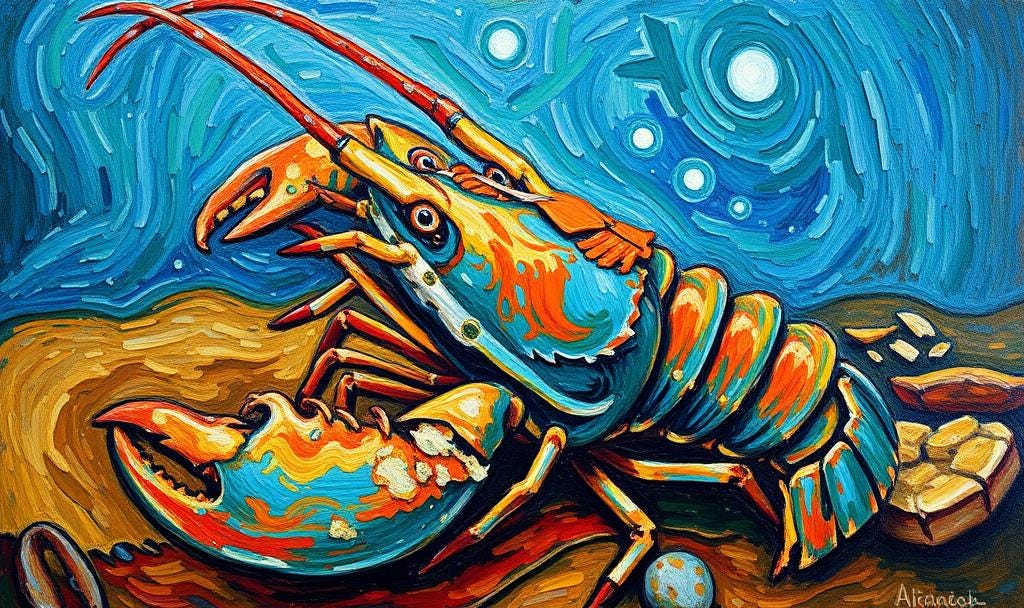You’re not stuck. You’re molting.
Lobsters have a strange way of growing. They don’t stretch like we do. Instead, they hit a point where their shell becomes too small. Tight. Constricting.
So what do they do?
They crack it open and crawl out. Exposed. Vulnerable. Raw.
And yet, that’s exactly how they grow.
If you’ve ever tried to break a habit, start a new routine, or shift your identity, you know this feeling. That awkward, in-between phase where the old version of you doesn’t fit anymore—but the new one isn’t fully formed.
Here’s what lobsters can teach us about becoming who we’re meant to be.
1. Growth Begins With Pressure
Before a lobster molts, it feels pressure. Its shell doesn’t grow, but its body does. Eventually, it becomes too uncomfortable to stay the same.
We go through this too. We outgrow behaviors, relationships, beliefs. You start to feel like something’s off. Your routines don’t align with who you want to be. That pressure isn’t failure—it’s a signal.
It’s your system saying, “Time to change.”
This is where transformation begins. Not in the comfort zone, but in the friction.
2. The Uncomfortable Middle Is Where the Magic Happens
Once the lobster decides to molt, it has to do something terrifying: it breaks itself free from its own shell. Every part of its body, even the delicate eye stalks, must slip out.
Likewise, when you step out of an old habit, you don’t just change your actions—you change your identity. You leave behind autopilot and enter a space where nothing feels familiar.
This is the messy middle.
You’re not who you used to be, but not yet who you’re becoming.
It’s easy to give up here. But this discomfort? It’s the heartbeat of transformation.
3. The Vulnerable Phase Is Necessary
After molting, the lobster is soft. Defenseless. It hides in the shadows while its new shell forms.
When you start a new habit, you’re in a fragile state too. You’re rewiring routines, resisting old urges, and trying to hold on to something that doesn’t yet feel natural.
This isn’t weakness—it’s biology. New patterns take time to stick.
So protect them. Limit distractions. Nurture the change. Give yourself the grace to not have it all figured out yet.
4. Reinforcement Is How You Grow Into the New Version of You
The lobster drinks in water to expand before its new shell hardens. That growth only happens during the window of vulnerability.
For us, the equivalent is repetition, structure, and environment. When you reinforce a new habit—by tracking it, celebrating tiny wins, and stacking it onto something you already do—you create room to grow into a more expansive version of yourself.
Don’t just rely on motivation. Build the scaffolding that makes change sustainable.
5. You’ll Outgrow Yourself Again (And That’s the Point)
Lobsters molt dozens of times over a lifetime. Each time they grow, they have to go through the same cycle: pressure, discomfort, vulnerability, growth.
You’re going to do the same.
Just when you think you’ve figured things out, life will nudge you again. And that’s okay. It’s not a setback. It’s a sign that you’re still evolving.
Final Thought:
If everything feels too tight right now—your routines, your mindset, your life—it doesn’t mean you’re failing. It means you’re growing.
You don’t need to be ready. You just need to start shedding.
Your next level won’t come through comfort. It will come through courage.
You are not stuck.
You are molting.






Bravo 👏 Laurie. I love all the stories you start with in your writing. It sparkles ✨ , I can connect to your point right away. I remember each story in your writing vividly and keep being mindful in my daily practice with some of your stories in my mind, so as you in my mind. You are an angel 😇.
This was a refreshing reminder. Most of the time, humans (myself) turn away from the discomfort. It's literally part of all life, yet most people resist thinking life should have time that are so hard. This is a very shortsighted way to live. Thnx for the reminder ✨️